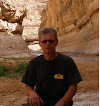Lusaka,
Pioneer Camp
At the camping both WIFi and internet of variable speed can be used and so I made a search in Google to find out what else is there interesting and worth to see here in Lusaka .
Basically, of course, markets and a few bigger shopping centers and Munda Wanga Park (already visited ), the National Museum (also visited). And then there was something unvisited - Kalimba Reptile Park, located 10 km north of Lusaka. Finding the place was no problem because already entering the city at the intersection a sign "Reptile Park," caught the eye, never mind that GPS showed another and a longer route.
In Africa it is generally safer to follow the signs and signposts, and if necessary, ask the local than to trust the GPS data on maps. So it was this time as well. Twenty minutes of driving along the red dusty African road - and there they were.
The place was like a usual reptile zoo with a picnic site and separate swimming pool for guests. The residents were the crocodiles of various sizes and ages, and there were indeed many of them , and also snakes, turtles. The ticket was 20,000 Kwacha or 4 USD.

The main inhabitants were the Nile crocodiles, the guide said that there were about 6000 of them of different ages and sizes. And they are raised primarily because of their skin.

The Nile crocodile is one of three African crocodile species, it may grow to 6 meters in length and weigh up to 730 kilograms, its menu consists mainly of fish, but he attacks everything alive that comes on its way either in the water or on solid ground.
Compared to all other reptiles, they have the most highly developed brain. Unlike many reptilians a female crocodile digs a half-meter deep hole a few feet away from the water and lays there 50-60 eggs, and then watches by the nest for the next 3 months, until the time of hatching has come.
The crocodiles takes care of their offspring for two years, until they are 1.2 meters long and are able to manage on their own. Read Wikipedia Link

Some are sleeping in the sunshine.

And some stare mouths open, until the food runs itself into the mouth. Perhaps something edible will still come. It's like a lottery ticket - will not win anyway, but having bought the ticket there could be at least an option to win perhaps

Next pool surrounded by wall. A year-old crocodiles further. The sides of the pool were full of them.

And closer look




Slender Snouted African Crocodile – another class of crocodiles with very sharp teeth. This crocodile can grow to 3-4 meters in length, lays an average of 16 eggs, lives mainly in Central and West Africa.
Read more from wikipediast






And as in this kind of farms the crocodiles are raised mainly for the skin - then their meat is in use as well - there was a small restaurant there too. .
Above is a picture of crocodile-burger. Had an idea to try this exotic dish. Completely edible. Tastes like spiced chicken. Price 2 USD



This is the scorpion of last night, this time smaller.
And right now – I think that I can post the blog and then a black creature crawls along the floor and stops under the table. Here it is:

The safest is to keep the feet on a chair. They do not climb up the plastic leg of a chair. And at night it would be safer to walk around in rubber boots. And a flashlight or headlamp must always be at hand, because you never know when the electricity goes out.



No comments:
Post a Comment